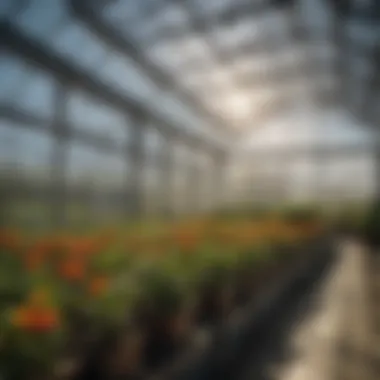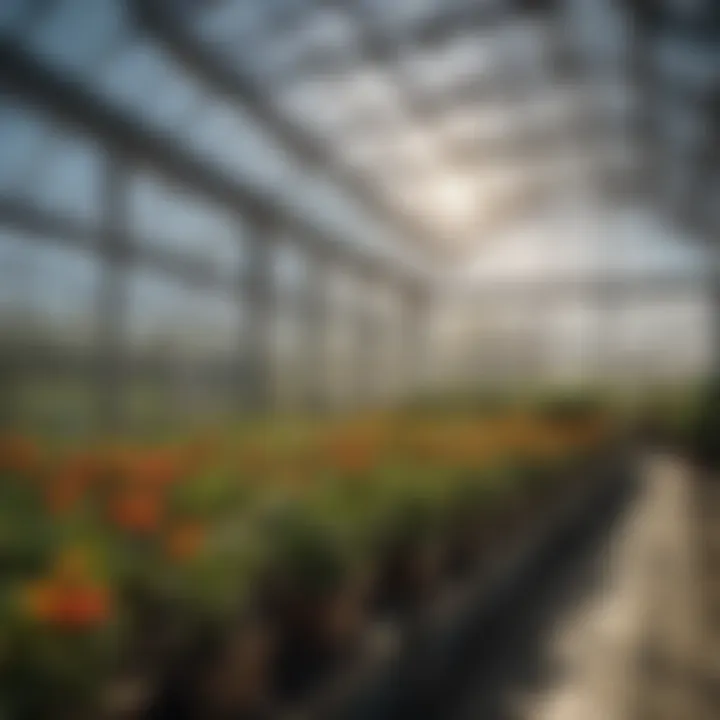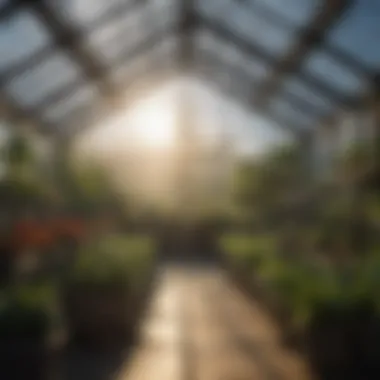Essential Components for a Greenhouse Setup


Intro
Creating a greenhouse is a rewarding venture in the realm of horticulture. It opens up a myriad of possibilities for growing plants in a controlled environment. This guide aims to equip enthusiasts with the necessary knowledge to set up an efficient greenhouse that promotes optimal plant growth. Understanding the essential components is vital, as they directly influence the effectiveness of the environment you cultivate.
Topic Overview
Definition and Importance
A greenhouse is a structure designed for growing plants in a sheltered environment. It allows for controlled regulation of temperature, humidity, and light, all of which are critical for plant health. The importance of having a greenhouse cannot be overstated; it extends the growing season, protects plants from adverse weather, and can even improve yield.
Brief History and Evolution
The concept of a greenhouse dates back centuries. Initially, they appeared as simple structures made from glass to enhance sunlight penetration while providing shelter. Over time, technology has advanced, leading to the development of modern greenhouses that utilize a range of materials such as polycarbonate and advanced ventilation systems. This evolution has made it easier for gardeners to create optimal growing conditions.
Key Components for Greenhouse Setup
Structure and Materials
- Frame Options: Common materials for greenhouse frames include aluminum, wood, and galvanized steel. Each has its advantages, with aluminum being lightweight and resistant to corrosion.
- Glazing: The choice of glazing affects light transmission and insulation. Glass provides a classic look but may not be as energy-efficient as polycarbonate panels.
A well-constructed frame paired with high-quality glazing can significantly enhance the greenhouse's efficiency.
Environmental Control Systems
- Heating Solutions: Depending on your climate, heating may be necessary. Options include electric heaters, gas heaters, and solar heating systems.
- Cooling and Ventilation: As temperatures rise, managing heat becomes crucial. Roof vents, side vents, and exhaust fans help regulate temperature and humidity.
Practical Applications
Step-by-Step Guides
Setting up a greenhouse involves several steps:
- Site Selection: Choose a location that receives ample sunlight while offering protection from harsh winds.
- Foundation Preparation: Ensure a solid foundation to prevent settling or shifting over time.
- Frame Assembly: Follow the manufacturer's instructions for constructing the greenhouse frame.
- Installation of Glazing: Carefully fit the glazing material to maximize light exposure and minimize heat loss.
- Setting Up Systems: Implement heating, cooling, and watering systems, tailoring them to your specific needs.
Case Studies or Real-World Examples
Many successful greenhouse setups can serve as inspiration:
- Urban Rooftop Greenhouses: Cities like Chicago have embraced rooftop gardens, showcasing sustainable practices and maximizing limited space.
- Commercial Greenhouses: There are numerous examples of large-scale operations that utilize advanced technologies for greenhouse management, achieving remarkable results.
Prologue to Greenhouse Essentials
A greenhouse serves a vital role in modern gardening and agriculture. Understanding the essential components involved in establishing an effective greenhouse setup is the first step towards successful horticultural endeavors. This introduction will outline the fundamental purposes of a greenhouse and the considerable benefits it offers to gardeners and farmers alike.
Purpose of a Greenhouse
The primary purpose of a greenhouse is to create a controlled environment for plants. This structure protects plants from extreme weather conditions, pests, and diseases. By regulating temperature, humidity, and light exposure, gardeners can extend the growing season, even into colder months. A greenhouse allows for year-round production of fruits, vegetables, and flowers, making it an invaluable resource for agricultural enthusiasts. With the right greenhouse, one can effectively manage various growth conditions tailored to specific plant requirements.
Benefits of Greenhouse Gardening
Greenhouse gardening comes with numerous advantages that appeal to both novice and experienced gardeners. Some of the key benefits include:
- Extended Growing Season: Greenhouses enable the cultivation of plants throughout different seasons, allowing for early planting and delayed harvesting, optimizing the production.
- Protection from Pests and Diseases: The enclosed environment can minimize the exposure to pests and diseases while providing an opportunity to implement integrated pest management strategies effectively.
- Controlled Climate Conditions: With adjustable temperature and humidity levels, gardeners can create ideal growing conditions for various plants, enhancing growth and yield.
- Space Efficiency: Utilizing vertical space is possible with the right orientation and design, allowing for higher productivity in smaller areas.
- Diversity of Plant Varieties: A greenhouse can accommodate a variety of plants that may not thrive in the local outdoor conditions, promoting biodiversity in gardening.
By exploring these fundamental components of greenhouse setup, readers will gain insights into the importance of this gardening solution. Understanding these essentials lays the groundwork for making informed decisions about greenhouse design, location, and operation, ultimately fostering a successful gardening experience.
Selecting the Right Location
Selecting the right location for your greenhouse is crucial. This decision influences light levels, temperature, and accessibilty for maintenance. Poor location choices can hinder plant growth, leading to decreased yields or even crop failure. Thus, it is essential to assess the environment before making this significant commitment.
Evaluating Sunlight Exposure
Sunlight is vital for plant health. Greenhouses typically require full sun exposure for the majority of the day. When choosing a site, observe how sunlight moves across the area you consider. Look for any obstructions such as trees or buildings that could shade your greenhouse.
Keep in mind:
- South-facing locations tend to receive the most sunlight throughout the day.
- Morning light is especially critical. It helps to warm the structure early, preventing plants from being stressed by cold temperatures.
- In warmer climates, partial shading may prevent overheating during peak sun hours. Selectively larger trees or shade structures can help with this.
Accessibility and Drainage Considerations
Accessibility is another key element in site selection. You want to ensure that you can easily reach your greenhouse for routine tasks such as watering, planting, and harvesting. Proper drainage is equally important. Water accumulation can lead to root rot or diseases. Here are some points to consider:
- Ensure that pathways lead to the greenhouse, making it easier for you to transport tools and plants.
- The site should be level to avoid water pooling. If the land is sloped, you may need to adapt the greenhouse foundation accordingly.
- Check existing drainage features in the area. Natural drainage paths can help channel water away from the structure.
Proper location selection ultimately enhances the efficiency of your greenhouse setup. It contributes to more robust plant growth and simplifies maintenance tasks.
By prioritizing these factors, your greenhouse will be better equipped for success. Ensuring that your plants thrive begins with selecting the right location.
Greenhouse Structure Types
Understanding the various greenhouse structure types is essential for anyone looking to establish a successful greenhouse setup. The choice of structure has a significant impact on the effectiveness of plant growth and environmental control. Selecting the right type can optimize conditions for several plant varieties while also influencing maintenance practices and overall costs.
Common Materials Used
Glass
Glass is a traditional choice for greenhouse construction. Its primary characteristic is transparency, allowing natural sunlight to penetrate effectively. This feature contributes significantly to optimal plant growth by creating a naturally warm and bright environment. Glass greenhouses can be very durable and withstand heavy weather conditions. However, one must also consider the disadvantages. Glass can be expensive, making initial investment relatively high. Additionally, they require proper framing and can be heavy, leading to complications in setup.
Polycarbonate
Polycarbonate is another popular option that offers unique benefits. This material is known for its strong thermal insulation properties. It allows for good light transmission while minimizing heat loss, which is crucial in cooler climates. The key advantage of polycarbonate is its lightweight nature, which eases construction and reduces required structural support. However, its cost can be on the higher side compared to polyethylene, and it may scratch more easily than glass, potentially affecting its light transmission over time.
Polyethylene
Polyethylene is often used due to its affordability and flexibility. This material is lightweight and easy to handle, allowing for simpler installation processes. Polyethylene coverings can provide adequate light diffusion while maintaining a temperature, which can benefit plant growth. However, it typically has a shorter lifespan than glass or polycarbonate. It may require replacement every few years due to wear and tear, impacting long-term costs and maintenance.
Design Options
Lean-to


Lean-to greenhouses are designed to attach to an existing structure, often a building. This design option is beneficial for optimizing space while utilizing heat from the adjacent structure. It is easier to construct and can be more affordable. However, the main limitation is the reduced exposure to sunlight if not placed correctly. Such structures may not be as versatile as freestanding options.
Freestanding
Freestanding greenhouses offer more flexibility in design and placement. They can access sunlight at all angles, maximizing yield potential for plants. This type allows for various sizes and shapes, permitting the owner to customize according to personal preference or available space. Yet, they may demand a higher initial investment compared to a lean-to design due to the need for a solid foundation and greater material requirements.
Hoophouse
Hoophouses are simple structures made from a series of hoops covered with plastic. They are low-cost and relatively easy to set up, making them popular among beginners. Their curved design effectively sheds snow and ice, which is practical in regions with harsh winters. However, they do not provide the same level of durability or insulation as glass or polycarbonate types, thus limiting their use in extreme climates. Additionally, their short lifespan means regular replacement is necessary.
Climate Control Systems
Climate control systems play a pivotal role in the success of a greenhouse setup. They ensure that the internal environment is conducive to plant growth by maintaining optimal temperature and humidity levels. This is essential, as different plants have varying requirements, and fluctuations can affect their health and productivity.
Heating Solutions
Heating solutions are critical during colder months, as they help to maintain a suitable temperature for plant growth. The most common heating methods are Electric Heaters, Gas Heaters, and Passive Solar Heating.
Electric Heaters
Electric heaters are a popular choice for greenhouse heating. They are known for their ease of use and ability to provide consistent heat. One key characteristic is their precise temperature control, which allows for steady warmth.
Their unique feature is the variety of sizes available, suited for different greenhouse sizes. Advantages include quick heating and minimal installation efforts. However, the disadvantage may arise from higher energy costs, particularly in larger setups.
Gas Heaters
Gas heaters are another common heating solution. They are generally efficient and can heat a large area quickly. A significant characteristic of gas heaters is their ability to function even during power outages, which can be beneficial.
Gas heaters often use natural gas or propane, which can be more economical for larger greenhouses. Unique features include the option for venting outside to improve air quality. But, disadvantages like the initial setup cost and safety concerns regarding gas leaks can be a consideration.
Passive Solar Heating
Passive solar heating utilizes the sun’s energy to warm greenhouses. This method incorporates design elements that capture and retain heat, such as thermal mass (like concrete or water barrels). A key characteristic of this method is its low operational cost once set up.
The unique feature of passive solar heating is its sustainability, promoting eco-friendliness. Advantages include reduced reliance on external energy sources and costs. However, it is less effective in cloudy or cold climates, which could limit its practicality in some regions.
Cooling Techniques
As essential as heating is cooling techniques. They help in managing the internal temperature during hot seasons. Common cooling methods include Ventilation, Shade Cloths, and Fans and Misting Systems.
Ventilation
Ventilation is crucial for preventing overheating in a greenhouse. It allows hot air to escape and brings in cooler outside air. A primary characteristic of good ventilation is the reliable movement of air, which promotes healthy plant respiration.
Natural ventilation, using windows and vents, is energy-efficient and cost-effective. The downside may be limited control on particularly hot days where manual intervention might be necessary.
Shade Cloths
Shade cloths help in reducing the sun’s intensity. Their primary aspect is the ability to block harmful UV rays while still allowing some light. This characteristic makes them a beneficial addition to the greenhouse, especially for heat-sensitive plants.
Unique features include varying degrees of shading options, which lets growers customize their environment. However, the disadvantage could be that shade cloths may require periodic replacement due to weather wear.
Fans and Misting Systems
Fans and misting systems work together to lower temperatures and increase humidity. The significant characteristic of these systems is their capability to cool through evaporation, providing immediate relief to plants.
They are beneficial for larger greenhouses where passive means may not suffice. Unique features include programmable settings, making them adaptable to various conditions. One disadvantage could be the maintenance required for optimal functionality, particularly in high-dust environments.
In summary, climate control systems are integral to a greenhouse setup. Understanding how to heat and cool it effectively can make a significant difference in the success of your gardening endeavors.
Watering Systems
Effective watering systems are one of the most crucial components in greenhouse management. They directly influence plant growth, health, and nutrient uptake. Proper hydration is essential for all plants, making it vital to choose the right method for your greenhouse. The choice of watering system also impacts labor efficiency, water conservation, and overall plant quality.
Manual Watering
Manual watering is the simplest form of irrigation, often favored by small-scale gardeners. It involves using watering cans or hoses to deliver water directly to the plants. This method allows for careful monitoring of soil moisture levels, ensuring that plants receive the right amount of water.
However, manual watering can be labor-intensive, especially in larger greenhouses. It may lead to inconsistency in watering, as human error can result in either overwatering or underwatering. Additionally, it does not lend itself easily to automated systems, which can be a drawback for growers looking to optimize time and resources.
Automated Irrigation Solutions
Automated irrigation systems facilitate efficient and consistent watering. These systems can be programmed to operate at specific times, reducing the manual labor required. There are several types of automated irrigation systems, each suited to different needs and crop types.
Drip Irrigation
Drip irrigation is a very efficient watering method. It delivers water directly to the roots of the plants through a network of tubes and emitters. This method minimizes water waste and reduces the chances of diseases caused by excessive moisture on plant foliage.
The key characteristic of drip irrigation is its targeted approach. Water is applied slowly, allowing it to seep deep into the soil, ensuring adequate moisture directly where it is needed. This system is also popular because it can be customized easily for different plant types and growth stages.
Advantages of drip irrigation include:
- Reduced water usage, which is environmentally friendly.
- Decreased labor costs due to automation.
- Prevention of soil erosion.
However, one potential disadvantage is the need for regular maintenance. Tubes and emitters can clog, requiring periodic inspections and cleanings.
Sprinkler Systems
Sprinkler systems are another common choice for greenhouse watering. They distribute water over a larger area, mimicking rainfall and ensuring even moisture distribution. These systems can cover various sizes, from small plots to extensive greenhouse setups.
The benefit of sprinkler systems is their ability to reach broad areas quickly. They are also easily automated, meaning you can set them to water during specific times or intervals. This helps in maintaining soil moisture consistently across the entire greenhouse.
However, disadvantages include:
- Potential water wastage through evaporation or runoff.
- Less targeted watering can lead to issues like water pooling and fungal diseases if not properly calibrated.
Hydroponics


Hydroponics is a soil-less growing method that uses nutrient-rich water solutions. This method supports fast growth rates and can lead to higher yields compared to traditional soil planting. Hydroponics allows for precise control over nutrient levels and offers the advantage of less water usage overall.
One significant characteristic of hydroponics is its ability to eliminate soil-borne pests and diseases. This can significantly reduce the need for pesticides, promoting a healthier growing environment. Additionally, hydroponics makes it possible to grow plants in locations with poor soil quality or limited space.
Advantages of hydroponics include:
- Fast growth and high yield potential.
- Efficient nutrient usage.
- Space-saving ability in urban gardening.
Nevertheless, the disadvantages are also notable. Hydroponics requires a higher initial investment and ongoing monitoring of nutrient solutions. If the system fails, plants may suffer quickly without proper care.
Understanding the various watering systems available is key to successful greenhouse management. Each option has its own set of benefits and limitations that should align with the specific goals of your horticultural endeavors.
Soil and Growing Medium Selection
Soil and growing medium selection is a cornerstone of successful greenhouse gardening. The type of medium you choose plays a significant role in plant health, growth rates, and yield quality. Different plants have varied requirements regarding nutrients, drainage, and moisture retention. Thus, understanding the right soil or medium is crucial for achieving optimal results. This section will explore various types of soil for containers and alternative growing mediums, focusing on their characteristics and relevance to greenhouse setups.
Types of Soil for Containers
Potting Mix
Potting mix is a specially formulated growing medium used for container gardening. It typically contains components like peat moss, vermiculite, and perlite, which together create an ideal environment for most plants. The key characteristic of potting mix is its ability to retain moisture yet allow for excellent drainage. This balance is essential for preventing root rot while ensuring that plants have access to water.
Potting mixes are beneficial because they are lightweight, making them easy to handle and suitable for various container sizes. A unique feature of potting mix is that it often comes pre-fertilized, providing initial nutrients to help plants establish themselves. However, one disadvantage is that over time, potting mix may compact, reducing aeration and drainage. Regular monitoring and rejuvenation of potting mix are necessary to maintain its effectiveness in greenhouse gardening.
Seed Starting Mix
Seed starting mix, as its name suggests, is designed specifically for germinating seeds. It is usually finer than regular potting mix, allowing seedlings to emerge easily. The primary characteristic of seed starting mix is its light and fluffy texture, which promotes root development and minimizes damping-off, a fungal disease that can affect young plants.
This type of mix is popular because it encourages rapid germination and strong early growth. A unique feature of seed starting mix is its absence of added fertilizers, which can be a double-edged sword: while it prevents burn from fertilizers, it means that once seedlings start to grow, you will need to provide nutrients soon thereafter. This demand for subsequent feeding may require more attention from the gardener.
Alternative Growing Mediums
Coconut Coir
Coconut coir is an organic material made from the husks of coconuts. Its popularity has grown in recent years as a sustainable alternative to traditional peat-based soils. The primary aspect of coconut coir is its excellent water retention and good drainage properties, making it suitable for a variety of plants. It's often used in combination with other mediums to enhance moisture retention.
A significant characteristic of coconut coir is its sustainability, as it is a byproduct of coconut processing. This gives it a unique advantage in environmentally conscious gardening practices. However, one disadvantage is that coconut coir does not contain nutrients on its own, so additional fertilizers will be necessary for plant health as they mature.
Perlite
Perlite is a volcanic glass that is crushed and heated, expanding into lightweight, white granules. Its primary role in soil mixes is to improve aeration and drainage. This makes perlite especially valuable in helping prevent root rot in container gardening within a greenhouse.
A key characteristic of perlite is its neutrality regarding pH, making it compatible with a wide range of plants. Its use in mixes increases the overall texture and allows for better oxygen flow to the roots. However, one downside is that it can float during watering, potentially leading to uneven distribution within the growing medium, which can affect plant growth unless properly managed.
Vermiculite
Vermiculite is a naturally occurring mineral that is heated and expanded into a lightweight substance. Its primary contribution lies in its ability to hold moisture and enhance nutrient retention. This characteristic makes vermiculite a useful addition to potting mixes, especially for plants that benefit from water retention.
Vermiculite is often chosen because it improves soil structure and can help to aerate heavier soils. It is beneficial for seed germination and root development. The unique feature of vermiculite is its capacity to absorb and hold nutrients, ensuring that plants have access to essential elements. Nevertheless, it can break down over time, which may lead to a reduction in its effectiveness as a growing medium.
Understanding the right soil and growing medium is fundamental for maximizing plant growth in a greenhouse.
In summary, careful selection of soil and growing mediums is vital for any greenhouse setup. Be it potting mix, seed starting mix, coconut coir, perlite, or vermiculite, each has its unique properties that cater to different gardening needs. Evaluating and understanding these characteristics will lead to improved plant health and productivity.
Essential Tools and Equipment
In a greenhouse, tools and equipment play a crucial role in ensuring optimal plant growth and maintenance. These items are not merely accessories; they are essential for any gardener's operational efficiency and overall success. Using the right tools can streamline tasks, prevent plant stress, and ultimately lead to a more fruitful harvest. Thus, understanding each tool's specific function and choosing quality equipment is vital.
Basic Gardening Tools
Trowels
Trowels are fundamental in a gardener's arsenal. They help plant, transplant, and cultivate soil. The key characteristic of trowels is their pointed blade, which allows for precision when working in small spaces, making them ideal for container gardening. The durability of trowels, especially those made from stainless steel, adds to their appeal, offering resistance against rust and corrosion. Their lightweight nature facilitates prolonged use without causing fatigue, which is advantageous for any greenhouse gardener.
However, one should consider the risk of less effective trowels causing strain when trying to manipulate stubborn soil. Proper trowels aid massively in achieving desired soil conditions without excessive effort.
Pruning Shears
Pruning shears are critical for maintaining healthy plants by ensuring proper growth and appearance. Their primary function is to cut and shape plants, promoting a dense, even structure. These tools typically feature sharp blades, which is a vital characteristic for enabling clean cuts, minimizing damage to the plant tissue. A well-designed pair of pruning shears can make a significant difference in work efficiency, helping prevent diseases by keeping plants well-trimmed and healthy.
While they provide excellent benefits, poor-quality shears can lead to jagged cuts, which may invite diseases. Therefore, investing in a high-quality pair will result in better overall plant health and ease the task of pruning.
Watering Can
A watering can serves as a primary tool to hydrate your plants evenly. A significant characteristic of a watering can is its ability to deliver water directly where needed without excessive spillage, hence reducing runoff and conserving water. The handle design often provides an ergonomic grip, which adds comfort and control when pouring.
One feature of watering cans may include a detachable spout for targeted watering. This allows for versatility when dealing with various plant sizes and types. On the downside, some may find watering cans cumbersome when managing larger workloads, as they may require frequent refilling.
Monitoring Equipment
Thermometers
Thermometers are essential for tracking temperature within the greenhouse. Accurate temperature readings are crucial in making informed decisions regarding heating and cooling needs. A primary characteristic to consider is whether a thermometer is digital or analog. Digital thermometers often provide immediate readings and can be more precise.
Thermometers may also include features like max/min temperature memory. This helps in monitoring temperature fluctuations and assessing plant comfort over time. Consider that analog thermometers might require periodic recalibration, which some might find inconvenient.
Hygrometers
Hygrometers measure the humidity levels within a greenhouse, which is an important aspect of climate control. High humidity can promote disease, while low humidity can stress plants. The key advantage of hygrometers is their ability to provide continuous moisture readings, helping in adjusting your watering practices.
A digital hygrometer often offers benefits like clear readings and additional features such as temperature tracking. Nonetheless, they can also be more expensive compared to basic analog models. Reliability can be an issue if the device is not well-calibrated, so regular checks are essential.
Soil Test Kits
Soil test kits help determine nutrient levels and pH in soil. This information is vital for understanding what amendments may be needed to enhance soil quality. Quality kits often allow for testing multiple parameters, giving comprehensive insights into soil health. They are particularly useful in tailoring fertilization and soil management practices.
A notable aspect of soil test kits is their simplicity in use—usually just mixing soil with provided reagents. Although the process may take some time, the insights gained are invaluable. Some kits may not always provide precise measurements, however, and professional testing services can offer more accuracy, albeit at a higher cost.


Plant Selection for the Greenhouse
Selecting the appropriate plants for your greenhouse is a critical step toward achieving successful horticulture. The right plants can maximize productivity, enhance biodiversity, and ensure a sustainable growing environment. Each plant type comes with its own set of requirements and capabilities, influencing your strategies about climate control, watering, and maintenance.
Surely, it is vital to consider factors such as growth conditions, desired yield, and your personal preferences when determining which plants to grow. This will not only simplify your care routine but also optimize the health of your plants.
Choosing Suitable Plants
Vegetables
Vegetables are a popular choice for greenhouse gardens. They are versatile and capable of providing a continuous source of nourishment. Many vegetables, including tomatoes, peppers, and cucumbers, thrive in greenhouse conditions where temperature and humidity can be closely monitored. Their adaptability makes them a beneficial option for this topic.
A unique feature of these plants is that they can be cultivated year-round in controlled environments, allowing for multiple harvests within a single year. This not only enhances food sustainability but also increases the enjoyment of fresh produce. However, keep in mind that some vegetables can be quite demanding in terms of space and resources.
Fruits
Fruits add a delightful variety to greenhouse gardening. They are often considered to be more challenging to grow compared to vegetables, yet they offer rewarding results. Strawberries, grapes, and even dwarf apples can be grown successfully in a greenhouse, making them a worthwhile choice.
Their key characteristic is that they often require specific pollination conditions. This can pose challenges, yet it also provides an opportunity to deepen knowledge in plant care. One of the advantages they bring is their potential for high market value. However, due to their longer growth cycles compared to vegetables, patience is needed to see the results.
Herbs
Herbs are another essential component of greenhouse gardens. Varieties such as basil, oregano, and rosemary not only enhance meals but also can be quite lucrative. Their quick growth cycle gives a fast return on investment, attracting many gardeners to incorporate them into their setups.
The unique feature of herbs lies in their aromatic and flavorful qualities. They often require less space and can grow in various conditions, making them a convenient choice. However, like any plant, they do have their own pests and diseases that need careful management.
Considerations for Companion Planting
Companion planting is a valuable strategy to maximize plant growth and minimize pests. This technique pairs plants that benefit each other, either through attraction of beneficial insects or through pest deterrence.
When selecting companion plants, consider the following:
- Compatibility: Ensure chosen plants have similar light, water, and nutrient requirements.
- Pest Control: Some plants can naturally repel pests when planted in proximity, reducing the need for chemical interventions.
- Space Utilization: Use plants that grow at different heights or root depths, optimizing the greenhouse's productivity.
Companion planting can improve the health and yield of your plants, making it an effective approach for any greenhouse gardener.
Ensuring the right plants are selected contributes significantly to the overall success of your greenhouse. Consider your choices carefully and embrace the possibilities of diverse plant interactions.
Pest Management Strategies
Effective pest management is vital for any greenhouse setup. Pests can significantly impact plant health and yield, making it essential to have a robust strategy in place. This section explores the importance of pest management and the various approaches available, helping you maintain a thriving greenhouse.
Preventive Measures
Preventive measures serve as the first line of defense against pests. By adopting a proactive stance, you can reduce the likelihood of infestations in the first place. Several effective strategies include:
- Regular Monitoring: Frequent checks can help detect problems early. Look for any unusual signs on your plants.
- Hygiene Practices: Keeping your greenhouse clean can prevent pests from finding a home. Dispose of waste properly.
- Use of Resistant Varieties: Choosing plant varieties that are less susceptible to pests lowers the risk of infestations.
- Diversity in Plant Selection: Incorporate a variety of plants to confuse pests and reduce their chances of finding their preferred hosts.
Implementing these measures helps to create an environment that minimizes pest-related challenges.
Integrated Pest Management (IPM)
Integrated Pest Management is a holistic approach to pest control. It combines various strategies for effective management while minimizing risks associated with chemicals. The components of IPM include:
- Monitoring and Identification: Recognizing the pests present in your greenhouse is crucial. This includes understanding their life cycles and behaviors.
- Threshold Levels: Determine when pest populations reach a level that requires action. Not all pests need immediate attention.
- Biological Control: Introduce natural predators or allies to reduce pest populations. Ladybugs and predatory mites are popular choices.
- Cultural Practices: Modify garden practices such as timing of planting and irrigation to hinder pest development.
- Chemical Controls: When necessary, use least-toxic pesticides in a targeted manner. Always consider non-chemical options first.
IPM offers a balanced method that promotes long-term pest management while supporting a healthy ecosystem within your greenhouse.
By understanding and implementing pest management strategies, you can foster an environment conducive to plant growth. Together, preventive measures and IPM create a comprehensive approach that secures the health of your greenhouse plants.
Maintenance Practices for Greenhouses
Maintaining a greenhouse is not just a matter of keeping plants alive. It is about creating an environment where they can thrive and maximize productivity. Proper maintenance practices are crucial for the long-term success of greenhouse gardening. These practices help in preventing pests, diseases, and inefficiencies that can hinder plant growth. A well-maintained greenhouse foster a healthier atmosphere, encourage plant resilience, and enhance overall yield.
Regular Cleaning and Inspections
Regular cleaning and inspections are foundational elements of greenhouse maintenance. Keeping the structure clean helps in minimizing the risks of mold, mildew, and pests, which can lead to significant losses. A thorough cleaning routine should include the following:
- Sanitizing surfaces: Wipe down tables, benches, and any surfaces that plants come into contact with. Using mild detergents can help remove pathogens.
- Removing debris: Debris can harbor pests and diseases, so it is essential to keep the area tidy. Dispose of fallen leaves, dead plants, and other organic matter regularly.
- Checking for structural integrity: Inspect the greenhouse for cracks, broken panels, or loose fittings. Any damage can lead to temperature fluctuations or create entry points for pests.
Seasonal inspections can further assist in identifying potential issues before they escalate. Addressing smaller problems at an early stage can save time, money, and plants. Regular monitoring of these conditions ensures a proactive approach to greenhouse health.
Seasonal Adjustments
Seasonal adjustments are vital to adapt the greenhouse conditions according to the changing climate. Plants have varying needs based on the season. Therefore, adjusting the environment is necessary to optimize growth at all stages. Here are some critical seasonal adjustments:
- Temperature control: During winter, additional heating solutions may be needed to keep the temperature sustainable. Conversely, in summer, ventilation and shading are essential to prevent overheating.
- Watering schedules: Watering needs change with the seasons. In spring and summer, plants might need more water, while in fall and winter, the demand decreases. Monitoring moisture levels will help in maintaining the right balance.
- Light exposure: Adjusting shading systems or curtains can help to moderate light intensity during peak sunlight months. This practice helps to ensure that delicate seedlings are not scorched.
"By regularly maintaining and adjusting greenhouse conditions, you not only enhance the health of plants but also create a productive gardening facility."
Implementing these maintenance practices enhances the longevity of greenhouse structures and supports the vitality of plants. Investing time in cleaning and adaptations will reflect in better harvests and a more sustainable gardening practice.
Ending
In the context of greenhouse gardening, reaching a conclusion is not merely an end. It is the summation of various critical elements discussed throughout the article. These elements ensure that greenhouse operations can be both productive and sustainable. Understanding the significance of each aspect helps gardeners to establish an effective greenhouse system that supports vigorous plant growth.
Recap of Key Considerations
A successful greenhouse setup relies on several key components:
- Location Selection: The site plays a fundamental role in maximizing sunlight exposure and ensuring proper drainage.
- Structure Type: Choosing between glass, polycarbonate, or polyethylene influences durability and cost-efficiency.
- Climate Control: Implementing appropriate heating and cooling systems helps maintain optimal growing conditions, critical for plant health.
- Watering Systems: Whether using manual or automated irrigation, a sound watering strategy is vital for sustaining plants.
- Soil and Growing Medium: The choice of soil or alternative mediums significantly affects nutrient availability to plants.
- Essential Tools: Having the right tools, such as thermometers and soil test kits, enables effective monitoring.
- Plant Selection: Understanding which plants to cultivate can enhance biodiversity and productivity.
- Pest Management: Developing preventive measures ensures that any infestation is managed effectively.
- Maintenance Practices: Regular cleaning and adjustments throughout the seasons are necessary for continued success in the greenhouse.
This overview serves as a reminder of the various factors that are interlinked in the greenhouse gardening process.
Future Considerations in Greenhouse Management
Looking ahead, there are several aspects of greenhouse management that demand attention. As the field of horticulture continues to evolve, being adaptable is crucial. Some vital future considerations include:
- Technological Advancements: The integration of smart technology can enhance monitoring systems, making it easier to track environmental conditions and optimize growth.
- Sustainability Practices: Incorporating sustainable practices will be more important due to global environmental concerns. This includes using renewable energy and reducing waste.
- Research and Development: Keeping abreast of new methods in pest management, such as biocontrol, can lead to more effective and environmentally friendly gardening methods.
- Community Engagement: Engaging with local gardening communities or online forums can provide fresh insights and support.
"Staying informed about innovations shapes a gardener’s ability to adapt to changing conditions and improves overall productivity."
In summary, applying these considerations will not only enhance the efficiency of greenhouse operations but also contribute positively to the wider interests in sustainable agriculture. The concluding thoughts encourage continuous learning and adaptability within the greenhouse gardening community.



